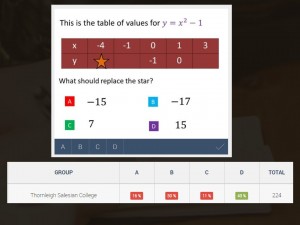“What misconceptions do GCSE students have when squaring negative numbers in the context of a table of values for a quadratic graph?”
The number of students around the country taking these weekly quizzes is growing and growing, and as it does, their teachers are learning more and more about the key holes in their knowledge. If you haven’t got invovled yet, now is the perfect time. It is completely free, and always will be.
Each week we set all our Year 11 Higher GCSE students a GCSE Essential Skills Quiz from my Diagnostic Questions website. These quizzes are completely free and are designed to test the content that appears on the majority of GCSE higher maths papers. These are the kind of questions that students should get right, but which time and time again cost our Year 11s the valuable marks that prevent them getting the grade they want.
We set our quizzes on a Monday, the students complete them for Friday, and then I sit down with a Mellow Birds coffee and a yoghurt (it is the weekend, after all) to analyse the results. I try to find one key insight, and then share it with staff in our weekly Departmental Meeting in a 5 minute slot called “Insight of the Week”.
Quiz 3 is below, followed by the key insight from this week.
How our students performed compared to the rest of the world:
We had issues with interpreting pie charts and area in context, but our Achilles’ heel this week was all about negative numbers:
Only 43% of our Year 11s got the question correct, with option C tempting almost one third of them:
Negative numbers is a tricky issue for many students. Confusion about when to apply the famous “two minuses make a plus” rule (a rule, incidentally, that is illegal to say in my classroom), together with issues around squaring numbers, which direction to move on number lines, and the context of the table of values all seem to have contributed to the problems students found with this question. Let’s dive in and have a look at their answers and explanations.
Incorrect Answer A (16% of our students chose this)
A classic error, with students believing that -4 multiplied by -4 equals minus 16. Crucially, this group of students have an additional misconception when it comes to subtracting numbers from negative numbers as they believe that -16 – 1 = -15.
“-4 squared = -16 – 1 = -15”
Incorrect Answer B (30% of our students chose this)
Our most popular incorrect answer, catching the eye of almost 1 in 3 of our Year 11s. The misconception here is the same as the one above, but with a correct final step:
“x = -4 to find y… y = -4 squared – 1 -16 -1 = -17 y = -17”
“-4^2 equals -16. – 1 off that puts it to -17”
Incorrect Answer C (11% of our students chose this)
C is a different kettle of fish. Here students have remembered that when you square negative numbers they become positive, but have made the classic mistake of doubling instead of squaring:
“-4^2 = 8 -1 = 7”
The Correct Answer!
One of my motivations for developing Diagnostic Questions was so that students all around the world could learn from each other. When your students finish a quiz, please encourage them to review their answers, reading through other students’ explanations, until they find the magic one that makes sense to them. So, what are our Year 11 students’ favourite correct explanations to help them resolve their own misconceptions?
“-4 x -4 = +16 (two minuses make a positive) 16 – 1 = 15”
“because -4 squared =16 and then take one =15”
Tackling the Misconception in Class
So, when we discussed this insight in our Departmental Meeting, what ideas did we come up with for resolving the misconceptions in lessons this coming week with our students:
- I have always taught negative numbers using the bowl of soup method. I wrote an article about it back in 2011 here. There are lots of other ways teachers have of providing some sort of context for negative numbers that avoids potentially dangerous rules, including Harry Potter style potions, good and bad deeds, trains going into and out of tunnels, linking it to speed, and more! Perhaps this is the way forward.
- Write out -4 squared in full as -4 x -4
- A few of us suspected out students were using a calculator, and falling into the deadly trap of typing in -4^2 and getting -16 out. So, it would be a case of reinforcing the need to add brackets around all negative numbers when using a calculator, and showing a few examples of how the trusty calculator can in fact let you down!
- We thought relating the question to the actual quadratic graph it produces was important. If students are expecting the U-shape of a positive quadratic, and go ahead and plot their co-ordinates, then they are likely to notice there is a problem when one of their points does not fit the pattern.
Please add any extra ideas in the Comments section below!
The series of GCSE Essential Skills Quizzes are available here and will always be completely free.
Quiz 4 is available here
I hope these quizzes will prove useful to help your students develop the essential skills necessary for success at GCSE, and aid your teachers gain a deeper understanding of how your students learn.


